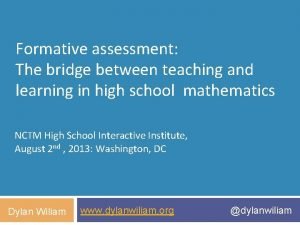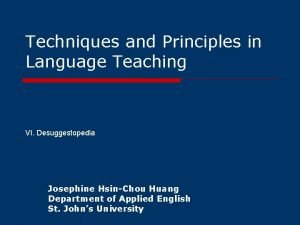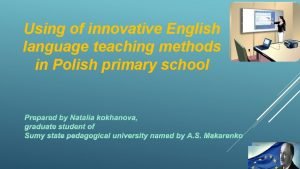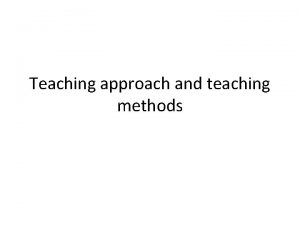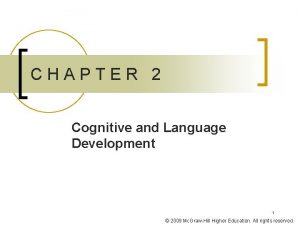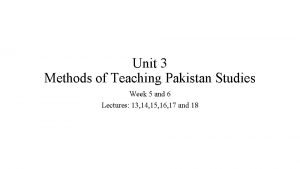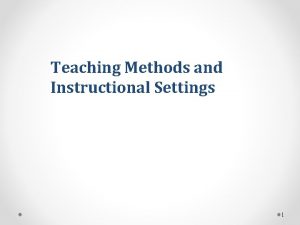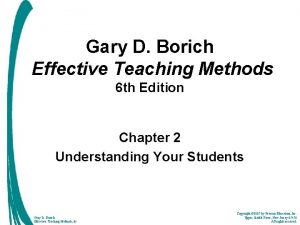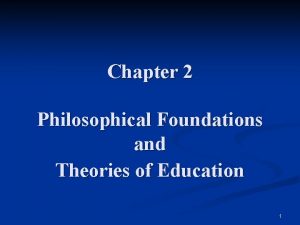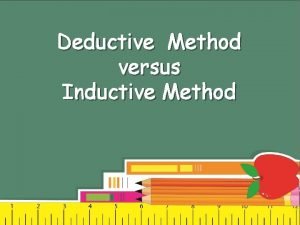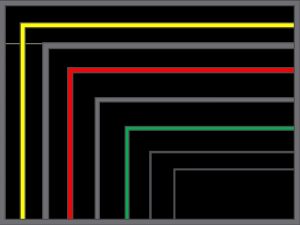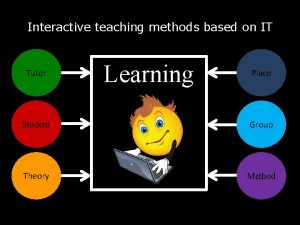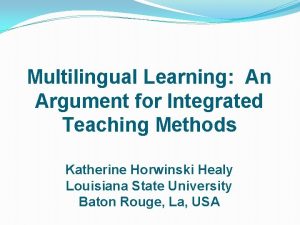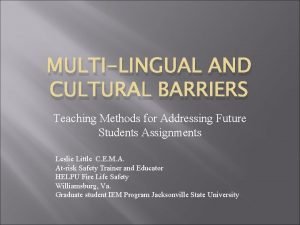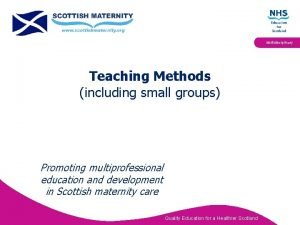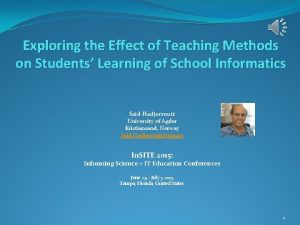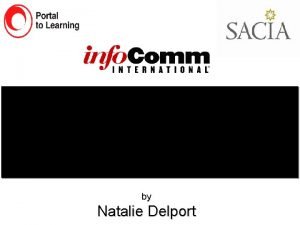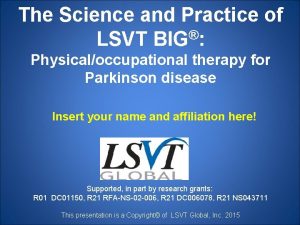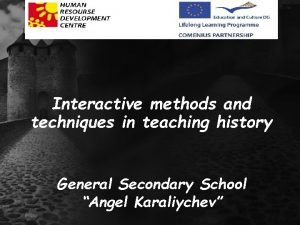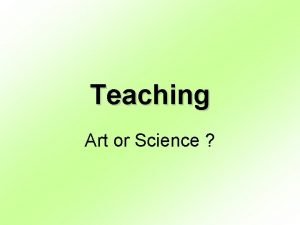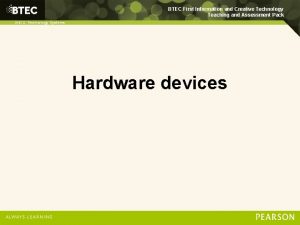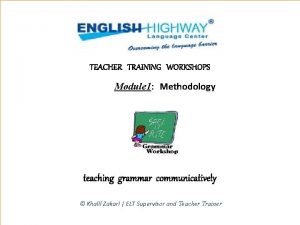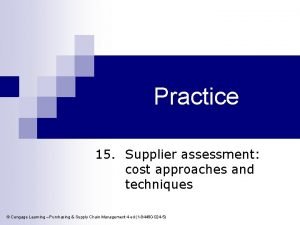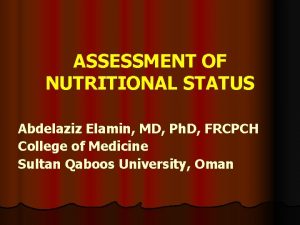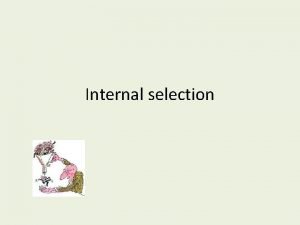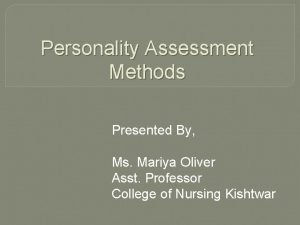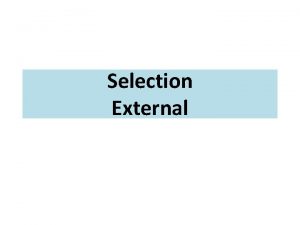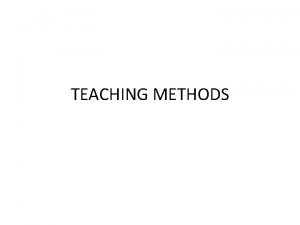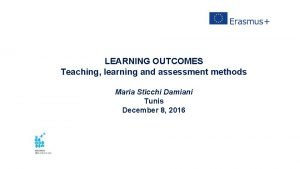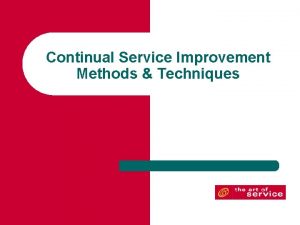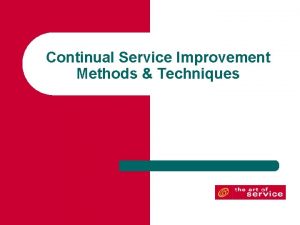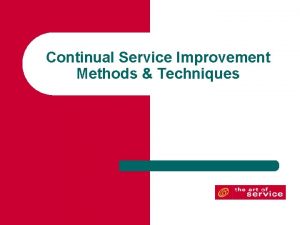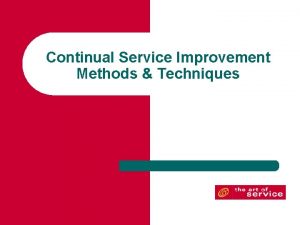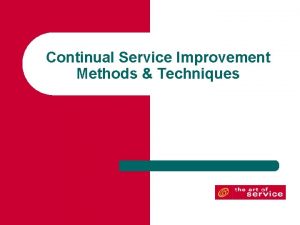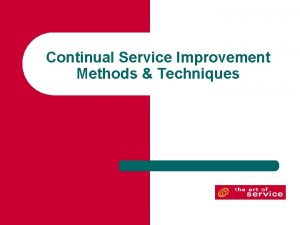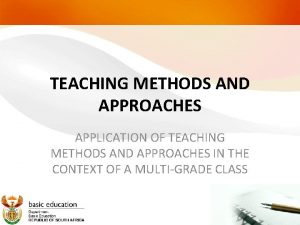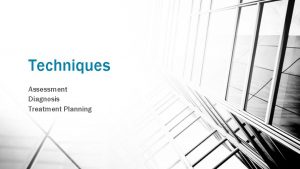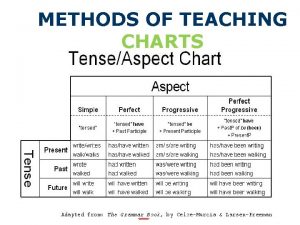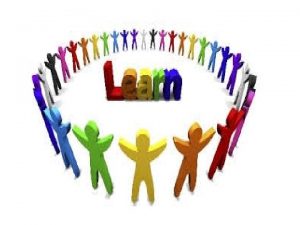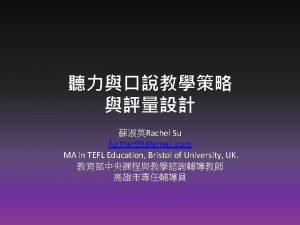Techniques and Methods for Teaching and Learning ASSESSMENT









































- Slides: 41

Techniques and Methods for Teaching and Learning

ASSESSMENT OF THE LEARNER Assessment is essential to determine learning needs so that an instructional plan can be designed to address deficits in any of the cognitive, affective, or psychomotor domains (Gessner, 1989). The purposes of assessing learning needs are to discover what has to be taught and to determine the extent of instruction or if instruction is necessary at all.

The following are important steps in the assessment of learning needs: • 1. Identify the learner. • 2. Choose the right setting. • 3. Collect data on the learner. • 4. Include the learner as a source of information. • 5. Involve members of the healthcare team. • 6. Assess demands of the organization. • 7. Prioritize needs.


Criteria for prioritizing learning needs Mandatory: Needs that must be learned for survival or situations in which the learner’s life or safety is threatened. Learning needs in this category must be met immediately. For example, a patient who has experienced a recent heart attack needs to know the signs and symptoms and when to get immediate help.

Desirable: Needs that are not life-dependent but are related to well-being or the overall ability to provide quality care in situations involving changes in institutional procedure. For example, it is important for patients who have cardiovascular disease to understand the effects of a high-fat diet on their condition. It is desirable for nurses to update their knowledge by attending an in-service program when hospital management decides to focus more attention on the appropriateness of patient education materials in relation to the patient populations being served.

Possible: Needs for information that are “nice to know” but not essential or required or situation in which the learning need is not directly related to daily activities. The patient who is newly diagnosed as having diabetes mellitus most likely does not need to know about major complication and renal or neurological future deficit.

METHODS TO ASSESS LEARNING NEEDS • • • Informal Conversations Structured Interviews Focus Groups Self-Administered Questionnaires Patient Charts: (Often documentation in patient charts will create patterns that reveal learning needs. Physicians’ progress notes, nursing care plans, nurses’ notes, and discharge planning forms can also provide information on learning needs. ) • Tests • Observation

Readiness to Learn • These four types of readiness to learn may or may not prove to be obstacles to learning. Nevertheless, the few minutes the educator spends assessing learning readiness can help overcome these possible obstacles.

the four types of readiness to learn(4 PEEK) P = PHYSICAL READINESS • Measures of ability • Complexity of task • Environmental effects • Health status • Gender E = EMOTIONAL READINESS • Anxiety level • Support system • Motivation • Risk-taking behavior • Developmental stage E = EXPERIENTIAL READINESS • Past coping mechanisms • Cultural background • control • Orientation K = KNOWLEDGE READINESS • Present knowledge base • Cognitive ability • Learning disabilities • Learning styles

Health Education Methods Ø Methods refers to ways through which messages are conveyed to achieve a desired behavioral changes in a target audience. Ø In health education it is not enough to decide what will be done; by whom and when, we also need to decide how it will be done (methods).

Common teaching method in health Common health education methods education Informal methods Formal methods 1. 2. 3. 4. 5. 6. 7. 8. 9. 10. 12 Health talk Lecture Brainstorming Group discussion Buzz group discussion Demonstration Role play Drama Case studies Traditional media Conference workshop Seminar Panel discussion Symposium

1. Health talks ü It is the most natural way of communicating with people to share health knowledge and facts. ü Can be conducted with one person or with a family or group of people or through mass communication 13

2. Lecture • It is oral, simple, quick and traditional way of presentation of the subject matter. • Presents factual material in direct, logical manner • Economical • In most cases audience is passive

Forms of lecture Traditional lecture Teacher is the only speaker • Participatory lectures Begins with learner • brainstorming and use break in between Feedback lecture Mini lectures followed by small • group discussion, it gives opportunity to manipulate lecture content Mediated lecture Use of media such as films, • slides along with traditional methods By : ATG(BSc, MPH)

3. Group discussion Ø The participants have equal chance to express freely and exchange ideas Ø The subject of discussion is taken up and shared equally by all the members of the group. Ø It is collective thinking process to solve problems. Ø Extremely useful in health education express ideas clearly and concisely listen to what others say do not interrupt when others are speaking make only relevant remarks accept criticism gracefully and help to reach conclusions

Group D… Strengths �Pools ideas and experiences from group �Effective after a presentation, film or experience that needs to be analyzed �allows everyone to participate in an active process Limitations �Not practical with more than 20 people �Few people can dominate �Others may not participate �Time consuming

4. Buzz group �A large group is divided into small group, of not more than 10 or 12 people in each small group and they have given a time to discuss the problem. �Then, the whole group is restarted and the reporters of the small groups will report their findings and recommendation

5. Brainstorming • Instead of discussing the problem at great length the participants encouraged to make a list in a short period of time all the ideas that come to their mind regarding the problems without discussing among themselves • Is a means of eliciting from the participants their ideas and solution on health issues.

Brainstorming… Strengths Ø Allows creative thinking for new ideas Ø Encourages full participation because all ideas equally recorded Ø Draws on group's knowledge and experience Limitations Ø If not facilitated well, criticism and evaluation may occur

6. Demonstration Ø “Showing how is better than telling how. ” Ø Although basically focuses on practice/skill it involves theoretical teaching as well. Chinese proverb; Ø If I hear, I forget Ø If I see, I remember Ø If I do, I know

Demonstration … Note that, Ø You remember 20% of what you hear Ø You remember 50% of what you hear and see Ø You remember 90% of what you hear, see and do and with repetition close to 100% is remembered. üDemonstration can be used with individuals and small groups. üIf the group is too large, members will not get a chance to practice the skills and ask questions.

7. Role-play �A type of drama in a simplified manner. It portrays expected behavior of people. �A role-play is a spontaneous and/or unrehearsed acting out of real-life situations. A script is not necessary. • It is a very direct way of learning; you are given a role or character and have to think and speak immediately with out detailed planning. Few minutes for instruction and 5 -10 minutes for them to plan & think • A role play should last about 20 minutes. • Allow another 20 -30 minutes for discussion • People can better understand their problem and the behavior associated with the problem

8. Drama • Drama is a presentation, in which the subject matter or topic is studied well either written or in words, and then presented in educative and recreating manner. • Needs detail planning and script development , practicing

9. Case study Ø Case Study: is an indepth analysis of real or simulated problems that help audiences to identify problems and suggest solutions according to their own contexts. 10. Traditional media Poems Songs Dances Games Stories (1 (2 (3 (4 (5

Traditional media … Traditional Medias are useful for the following reasons • They are realistic and based on the daily lives of local people • They can communicate attitudes, beliefs, values and feelings in powerful ways. • They can motivate people to change behavior. • They can show ways to solve problems. • Usually they are very interesting.

Selection methods for health education • Consider the following things before choosing health education methods. 1. 2. 3. 4. How ready and able are people to change? Your ‘learning’ objectives. How many people are involved? Is the method appropriate to the local culture?

Selection …. 4. What resources are available? 5. What mixture of methods is needed? 6. Subject matter 7. Limitations of time 8. What methods fit the characteristics of the target group?

Scientific methods 29

2. Formal methods-Scientific methods 1. Seminar: ü A seminar is a lecture or presentation delivered to an audience on a particular topic or set of topics that are educational in nature. ü Seminars are educational events ü It is usually held for groups of 10 -50 individuals for about an hour though usually not in practice.

2. workshop ü is a period of discussion and practical work on a particular subject in which a group of people share their knowledge and experiences. • It is a series of educational and work sessions (where manual work is done). • Small groups of people meet together over a short period of time to concentrate on a defined area of concern.

3. Symposium ü is typically a more formal or academic gathering, featuring multiple experts delivering short presentations on a particular topic. Ø It is an academic in nature where experts (academicians ) present their views on a particular theme. Ø Eg. annual research symposium Ø No discussion among the symposium members. Ø Chair person makes a comprehensive summary at the end

4. Conference: Conference refers to meeting for lectures of discussion where representative of various stakeholders participate. Ø Conference has a far broader spectrum of meaning than the other three (seminar, workshop, symposium ). Ø Not limited to academic activities only; beyond academic where many diverse participants participate

5. Panel discussion: is a meeting where experts (two or more) are invited to make short presentation or speak on different aspect of the same subject area or theme. • Eg. Theme-mental health in Ethiopia. Expert 1: history of mental health in Ethiopia Exeprt 2: Mental health and health policy Expert 3 : Future of mental health

Health Learning Material • Health learning materials: are those teaching aids which give information and instruction about health specifically directed to a clearly defined group of audience. • programs rely on them • Are considered cross cutting issue for public health interventions nowadays.

Health Learning Materials (HLMs) There are four types of health learning materials: 1. Printed HLMs 2. Visual HLMs 3. Audio HLMs 4. Audio-visual HLMs

Poster is a large • sheet of paper ranging in size from large bill boards to small notices. Poster But often it has • a size of 40 cm wide and 60 cm high.

Poster. . A poster consists of ; words and pictures or symbols that include a message on it. 38 By : ATG(BSc, MPH)

Content of poster All words in a poster should be in language the community understand or in two languages. The words should be few and simple to understand slogan -contain a maximum of 7 words.

Purpose of posters • To reinforce/remind a message the public is receiving through other channels. • To give information and advice. E. g. learn more about malaria! • To give directions and instructions for actions. E. g. a poster about malaria prevention methods. • To announce important events and programs. E. g. World Malaria Day.

THANKS ALOTS
 Assessment the bridge between teaching and learning
Assessment the bridge between teaching and learning What is documentation portfolio
What is documentation portfolio Portfolio assessment matches assessment to teaching
Portfolio assessment matches assessment to teaching Teaching approach
Teaching approach Cuadro comparativo de e-learning
Cuadro comparativo de e-learning Definitions of micro teaching
Definitions of micro teaching Inlay wax pattern fabrication
Inlay wax pattern fabrication Techniques and principles in language teaching
Techniques and principles in language teaching Innovative methods of teaching english language
Innovative methods of teaching english language Characteristics of good teaching methods
Characteristics of good teaching methods Piaget teaching methods
Piaget teaching methods Project method of teaching
Project method of teaching Teaching methods definition
Teaching methods definition Remedial teaching materials for slow learners
Remedial teaching materials for slow learners Ethurom
Ethurom Pragmatism teaching methods
Pragmatism teaching methods How to use direct method in teaching english
How to use direct method in teaching english Deductive methods of teaching
Deductive methods of teaching Laboratory method of teaching
Laboratory method of teaching Interactive teaching methods
Interactive teaching methods Multilingual teaching methods
Multilingual teaching methods Multilingual teaching methods
Multilingual teaching methods Set dialogue closure
Set dialogue closure Method of teaching slideshare
Method of teaching slideshare Strengths and weaknesses of observation assessment methods
Strengths and weaknesses of observation assessment methods Fundamental teaching techniques of lsvt big
Fundamental teaching techniques of lsvt big Techniques of teaching history
Techniques of teaching history What is teaching techniques
What is teaching techniques Btec level 2 information and creative technology
Btec level 2 information and creative technology Teaching and assessment of grammar module 1
Teaching and assessment of grammar module 1 Fonction technique scooter
Fonction technique scooter Supplier evaluation techniques
Supplier evaluation techniques Abcd nutrition assessment
Abcd nutrition assessment Initial assessment methods for internal selection
Initial assessment methods for internal selection Personality assessment methods
Personality assessment methods Initial assessment methods for hiring
Initial assessment methods for hiring Portfolio assessment methods
Portfolio assessment methods Types of assessment questions
Types of assessment questions Fspos
Fspos Typiska novell drag
Typiska novell drag Tack för att ni lyssnade bild
Tack för att ni lyssnade bild Returpilarna
Returpilarna
